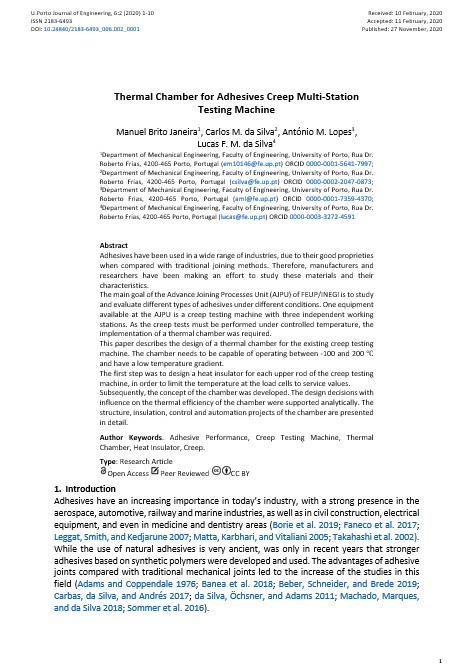Thermal Chamber for Adhesives Creep Multi-Station Testing Machine
Main Article Content
Abstract
Adhesives have been used in a wide range of industries, due to their good proprieties when compared with traditional joining methods. Therefore, manufacturers and researchers have been making an effort to study these materials and their characteristics.
The main goal of the Advance Joining Processes Unit (AJPU) of FEUP/INEGI is to study and evaluate different types of adhesives under different conditions. One equipment available at the AJPU is a creep testing machine with three independent working stations. As the creep tests must be performed under controlled temperature, the implementation of a thermal chamber was required.
This paper describes the design of a thermal chamber for the existing creep testing machine. The chamber needs to be capable of operating between -100 and 200 ºC and have a low temperature gradient.
The first step was to design a heat insulator for each upper rod of the creep testing machine, in order to limit the temperature at the load cells to service values.
Subsequently, the concept of the chamber was developed. The design decisions with influence on the thermal efficiency of the chamber were supported analytically. The structure, insulation, control and automation projects of the chamber are presented in detail.
Downloads
Article Details
Authors who publish with this journal agree to the following terms:
- Authors retain copyright and grant the journal right of first publication with the work simultaneously licensed under a Creative Commons Attribution License that allows others to share the work with an acknowledgement of the work's authorship and initial publication in this journal.
- Authors grant the journal the rights to provide the article in all forms and media so the article can be used on the latest technology even after publication and ensure its long-term preservation.
- Authors are able to enter into separate, additional contractual arrangements for the non-exclusive distribution of the journal's published version of the work (e.g., post it to an institutional repository or publish it in a book), with an acknowledgement of its initial publication in this journal.
- Authors are permitted and encouraged to post their work online (e.g., in institutional repositories or on their website) prior to and during the submission process, as it can lead to productive exchanges, as well as earlier and greater citation of published work (See The Effect of Open Access).

